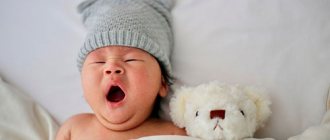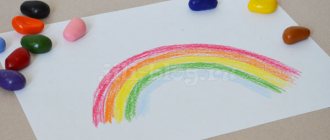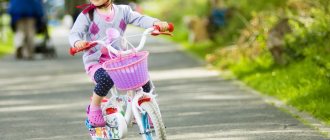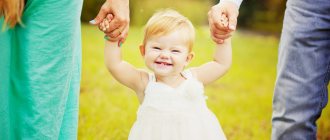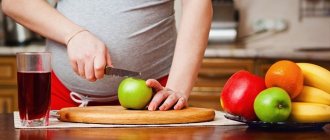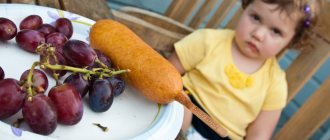The development of each baby is individual. Some people start talking earlier, some start walking earlier, and some grow out all their baby teeth faster. But all children, without exception, at this age, 2 years and 3 months, become more active and curious. The task of caring parents is to help their child understand the world around him and acquire new skills.
See, a detailed calendar of child development from birth to 3 years by month
Physical development of a baby at 2 years 3 months
Every day the baby's steps become more confident. He less and less often needs to hold an adult's hand to overcome obstacles (steps, bumps, climbing up a slope).
During the walk, the baby actively moves, runs and jumps, shows interest in the rides and horizontal bars, and tries to climb the ladder. In the sandbox he sculpts figures from sand, uses toys for their intended purpose (digs sand with a shovel, collects it in a bucket).
Children learn to dress and undress independently. Some people prefer to choose what to wear before leaving the house, without hesitation to insist on their choice. Nothing wrong with that.
If the little one’s choice matches the weather outside, support him. If the child may be cold in the chosen outfit, then offer to complement his “look” with a warm jacket, hat or jacket.
During this period, coordination continues to improve and the activity of the right hand (or left, if the child is left-handed) and index fingers begins to predominate.
At 2 years 3 months, children learn to open and close doors.
Parents need to be careful and make sure that their beloved child does not get his fingers pinched!
By this age, the baby sleeps no more than 10 hours at night, and during the day 2-3 hours of sleep after a walk and lunch is enough.
The feeding process is simplified because the baby independently operates a spoon and drinks from a cup without spilling its contents.
Motor skills.
A properly selected developmental environment is very important for a baby. What toys should I buy so that they don’t turn out to be superfluous and unnecessary? How to choose in the store exactly what your baby needs according to her age? Read all this in the article: “What toys are needed!”
Skills:
- Undresses and dresses independently (shirt, tights, pants, hat).
- Freely manipulates clothes with buttons.
- Learns to fasten buttons. Large buttons are easy, small ones are difficult.
- Doesn't know how to tie shoelaces yet.
- Brings a plate and spoon for food.
- Can eat thick and liquid foods independently with a spoon. At the same time, he holds the spoon in his right hand, lowering it into the plate, bending slightly over the table.
- Drinks from a cup without spilling the contents. Tries not to dirty clothes and the table.
- Holds bread with his left hand, knows how to bite off small pieces.
- He pays attention to his dirty hands and face, shows the adult that he is dirty, and tries to wipe himself off with a napkin.
- He detects disorder at the table (no napkin, presence of crumbs) and demonstrates his comments.
- Hygiene - lathers hands with soap, washes them in circular motions, places palms under running water, shakes off droplets from hands, wipes them with a towel. Confidently moves a toothbrush over his teeth and a comb through his hair.
- Continues to play in the sandbox and make Easter cakes of different shapes.
Modeling
- He plucks pieces from soft plasticine or dough and crumbles it.
- He knows how to roll sausages, a ball, and loves to squeeze the ball into a flat cake in the form of a saucer. On plasticine cakes he squeezes out seals in the form of a pattern.
- Using a stack (a plastic knife in a set with plasticine), he learns to cut sausages into small pieces.
Visual activities
- Continues to love drawing with paints and felt-tip pens.
- He doesn’t really like to draw with pencils, as he has to press on them. (For proper grip, it is better to use a triangular pencil).
- He knows how to not only draw lines - vertical, horizontal, intersecting, but connects them with specific images (Rain is dripping, grass is growing).
- Draws roundness (circles) like a ball, the sun.
On the subject: How to do baby massage?
Construction and games with objects:
- Actively uses substitute objects:
“Mom, let’s eat some porridge!” — the child holds out a plastic saucepan full of sand.
"It's a horse!" says the boy, straddling a stick and jumping around the room.
- Quickly folds a pyramid of 6 rings.
- Builds various buildings from cubes that are already involved in the plot. (A house with a pipe for a doll made of cylinders, bricks and a prism, a car made of cubes, a garage made of bricks).
- They are still attracted to rough cubes that can stick together. Takes an active interest in building with Lego.
- Creates a large mosaic. It forms flowers from it - the center is white, the petals are red, etc.
- Learn to play lotto animals. Finds identical pictures and puts them next to each other.
- Developing skills in working with paper - tearing it off, crumpling it into lumps.
- Uses tools for story games. If you need to fix a table or repair a machine, he finds a saw, a screwdriver, and pliers and uses it for its intended purpose.
- Masters the skills of creating a general drawing from 2 cut pictures.
- Adds lacing with large holes to your games. (Tree with fruits).
- Plays finger puppet theater with an adult.
Peculiarities of the psyche in children aged 2 years and 3 months
At two and 3 months, the child begins to recognize himself as a separate person. This helps to increase interest in the people around him, protest against restrictions on his freedom of action and express his preferences.
The baby tries to perform some action (put away toys, take a bottle to the kitchen, get dressed, etc.) efficiently, expecting praise from adults.
Children should definitely be praised for good deeds and attempts to learn something new. Under no circumstances should you mock them if they fail at something! This can cause psychological trauma to the younger generation.
Children aged 2 years and 3 months like consistency, a calm home atmosphere, and interaction with familiar objects. Despite this, if necessary, the baby quickly adapts to new surroundings and conditions, thanks to the plasticity of the psyche.
Going to kindergarten entails separation from your mother, your closest person, for several hours or the whole day. Because of this, the child experiences stress, which can be expressed by hysterics, refusal to eat in kindergarten, resentment, apathetic or, conversely, aggressive behavior.
Try to draw your child's attention to the benefits of attending kindergarten. Point out the opportunity for him to communicate and play with peers and gain new skills and knowledge through classes with teachers.
Negative emotions contribute to a decrease in the baby’s activity, he loses interest in exploring the world around him. Therefore, he should not be left alone in a bad mood. Fortunately, it’s quite easy to cheer up a toddler at this age. Children at 2 years 3 months quickly switch to something new (playing, watching a cartoon, animal).
By this age, the range of emotions that a child is capable of experiencing is constantly expanding. The little one learns to empathize and be proud of himself when he is praised.
The baby needs the care of its parents and expects support and protection from them.
Expression of feelings and emotions.
- Continues to enjoy the capabilities of his body - walk back and forth, run, jump, step over objects.
- Retelling the plot of fairy tales, he empathizes with the main characters, accompanying his feelings with gestures and facial expressions. Uses quotes from fairy tales: “Trouble, trouble, run here quickly!”
- Actively expresses dissatisfaction. May become angry, indignant, complain, muttering and gesticulating.
- Expresses his love through hugs and kisses.
- Still expects parents to show their love and attention.
- Breaks into a smile when he receives approval and praise for his achievements. Waits for verbal encouragement for his successes.
On the topic: Child development by month to year.
Communication with others and speech of a child at 2 years and 3 months
The baby increasingly likes games with peers, which become more diverse. The little one willingly talks to family and friends, but is wary of strangers.
The vocabulary at this age reaches about 200 words and is constantly enriched.
It is advisable for parents to monitor their speech and ask friends who are in contact with the child to do the same.
Gradually, the “why” awakens in the baby, which begins to intensively terrorize adults.
It is necessary to answer the child in a friendly manner, trying to explain as clearly as possible what interests him. Under no circumstances should you show dissatisfaction. With your help, the baby will explore the world and learn new things.
Development of intelligence and cognitive processes of a child at 2 years 4 months
The child accumulates new knowledge, fine motor skills improve, coordination of movements is practiced, subtle manipulations with various objects become subject to him, and the “leading” arm and leg are determined.
What else can a toddler do?
- Hold a pencil or pen correctly (with three fingers).
- Draw vertical lines and similar circles.
- Distinguish 4 or more colors, 4-5 geometric shapes.
- Distinguish objects using color, shape, size.
- Build towers from 7-8 cubes.
- Build fences and houses from large construction kit parts and cubes - yourself, upon request, according to a model.
- Collect a pyramid of 3-4 rings in the correct sequence.
- Fold nesting dolls and sets of molds from smallest to largest.
- Play with inserts.
- Name simple objects correctly.
- Remember and complete a simple task of 3-4 actions: for example, go to the box, find a ball and give it to dad.
- Use objects for their intended purpose: draw with a pencil, eat with a spoon, wipe with a rag, scoop up sand with a shovel.
- Use substitute objects: for example, a stick is a gun.
- Imitate the actions of adults - everyday and professional: mother, salesperson, doctor - yourself or upon request.
- Play with another child, imitate his actions.
- Play simple outdoor games with a small group of children.
- Play without adults for 30-40 minutes.
New skills for babies at 2 years and 3 months
The list of what a child can do without the help of adults is constantly being updated. During walks, the norm is to jump from a height of 10-15 cm. The toddler can now not only throw a ball, attempts to catch it are increasingly proving successful.
By this age, children are able to entertain themselves for some time. On the one hand, this frees up some time for mothers and educators. On the other hand, it must be remembered that curiosity at this age is truly limitless.
Therefore, all objects that could pose a danger (cause injury, be swallowed, stuck in the ears, nose) should be out of reach of the little researcher.
The baby can learn small poems by heart and speaks in sentences of 3-5 words.
If a child stubbornly refuses to talk, this is not a reason to panic, but a visit to an experienced speech therapist will not be superfluous. A specialist will help you choose techniques that will enhance your “talkativeness.”
In addition, the toddler learns to quickly cope with fasteners, ties and buttons on clothes.
What should a 3 year old child know and be able to do?
By the age of three, children begin to actively speak and expand their vocabulary with new concepts and terms.
Even those children who previously showed little success in communication begin to actively use previously acquired knowledge. Over the course of six months, with systematic studies, they catch up with their more talkative peers, mastering all the necessary knowledge.
The average skills that a child should acquire by the age of three include:
- The ability to draw and explain what he draws. When drawing at this age, it is typical to use simple lines and figures, and possibly imitative writing in the image of an adult;
- Image of objects and scenes from life. Modeling from plasticine figures of familiar objects and people;
- Memorize poems and songs. This skill is formed through repeated repetition of one material by adults in a playful way.
Learning new material is carried out gradually: you can ask the child to first finish a line of a well-known poem or song, after which the number of words called by the child should increase.
Speech development
The vocabulary ranges from 250 to 700 words, some children show results of up to 1500 words, which are arranged in sentences of 5-8 words. The child expresses his feelings using words.
Words begin to change in numbers and cases, and questions related to knowledge of the world around us are transformed from the form “what is this?” in “where?”, “where?”, “why?”, “when?” according to the situation.
- When speaking, attempts at word creation and rhyming appear; when communicating, he speaks with pleasure to adults and children;
- Can tell about a read fairy tale based on a picture, restore the order of actions in a well-known fairy tale, show familiar objects and events in the image;
- Knows his first and last name. Knows his age and shows it on his fingers;
- Distinguishes people by gender and age;
- Knows the parts of the body and their purpose;
- Prepositions appear in speech.
Showing curiosity
- A three-year-old child can freely draw parallels in parts of the human body and animals;
- When playing, he actively uses the association of his own “I” with his favorite character, answers the question “who are you?” in Game;
- Uses role-playing conversations in the game, imitating various characters. Can voice both himself and the doll.
- The ability to recognize a familiar object or animal by detail appears (trunk - elephant, skirt - girl).
- Can count to three, knows the meaning of the words many and few.
- Begins to distinguish between left and right, but errors are still possible.
- Correctly names four primary colors and a number of shades, while already being oriented in the seven colors of the spectrum, knows black and white. Appeals with this knowledge, showing it in the picture at the request of an adult.
- Places objects one into another (matryoshka doll, bowls, caps) at the request of an adult or during independent play.
- Can recognize an object by touch and distinguishes texture.
- Puts together simple mosaics of 2-4 parts without the help of an adult.
- Builds turrets, houses and other familiar simple objects from cubes at the request of an adult or during independent play.
- Can do one activity for quite a long time.
At the age of three, many children begin to attend preschool educational institutions, but this is not a reason to stop homeschooling with the child. In such a situation, the adult must adjust the time of the lesson and the amount of information offered.
If parents send their child to kindergarten, it is worth adjusting the material for home study based on the kindergarten program, and offering the child classes in areas that are not available in the kindergarten.
If you liked the article, please share a link to it
Diet for babies 2 years 3 months
- Children need a balanced diet . There should be 4 meals during the day. Most foods must contain animal protein. There is a lot of it in meat, dairy products, eggs, poultry and fish.
- The protein menu must be supplemented with fresh fruits and vegetables , which contain many vitamins and microelements.
- The daily norm of meat products for children at this age is 85 g . It is allowed to give your child boiled or stewed lean veal, chicken, beef and pork in the first half of the day.
Meat takes a long time to digest, and such a dinner can cause problems with sleep.
- The best side dish is viscous porridge or stewed vegetables.
FAQ
What should a 2 year old child be able to do?
All children grow and develop at their own pace, but most children at this age or a little later perceive whole sentences by ear, put together simple puzzles of three or four elements, fantasize and know how to run.
But don't worry if your baby doesn't show any of these skills yet, because he develops at his own pace. What to feed a 2 year old child?
An approximate daily diet for a child at this age should include three full meals and two snacks. Avoid giving your baby foods that could cause a choking hazard, such as nuts, candy, popcorn, or hot dogs. Here's what you can offer a child at 2 years old:
- Breakfast:
½ cup cereal with ½ cup skim or low-fat milk, 1/3 cup chopped bananas or strawberries, 1/2 slice toasted whole grain bread with cheese.
- Dinner:
½ sandwich on whole grain bread with a piece of cooked meat or a slice of cheese, vegetables such as lettuce, tomatoes or avocado, two or three finely chopped carrot sticks, ½ cup of berries.
- Dinner:
60 g of boiled meat with 1/3 cup of boiled rice and 2 tablespoons of boiled vegetables.
- Snack:
four crackers with hummus, 1/2 cup finely chopped berries or half an apple, sliced.
What words should a 2 year old child say?
A 2-year-old child can usually construct simple sentences. His speech becomes more understandable and coherent, so that now he is understood by strangers who are not familiar with the peculiarities of the child’s speech and the words he has invented.
Tasty and healthy: recipes for every day for children aged two years 3 months
Children, like adults, get tired of eating the same thing every day. Therefore, caring mothers try to diversify the menu for their beloved children.
Omelette with zucchini
A hearty and tasty dish for 4-6 servings.
You will need:
- 4 eggs
- 2 medium zucchini
- 100 g cheese
- 2 cloves garlic
- 1 tsp. flour
- 250 ml milk
- 1 tomato
- 50 g fresh herbs
Zucchini must be washed thoroughly, grated on a coarse grater and squeezed out the juice. Add garlic squeezed through a press and salt to taste into a container with grated zucchini.
Mix flour with milk, add eggs, a little salt and mix. Grease the bottom of the mold with butter, lay out the grated zucchini and pour the milk-egg mixture over everything.
Scald the tomato with boiling water, remove the peel, cut into small slices and add to the casserole, sprinkle with chopped herbs and cheese on top.
The dish is baked in the oven at 180 degrees for half an hour.
Cream of chicken soup with broccoli
A good way to diversify the usual Lenten borscht and soups.
You will need:
- 1 chicken breast
- 5 florets of fresh broccoli
- 60 g butter
- A couple of croutons
- Sour cream
The chicken must be washed, covered with water, lightly salted and cooked for 50 minutes. During the cooking process, foam will form on the surface of the water, which must be skimmed off.
Remove the boiled breast from the broth and place in a clean container to cool. Rinse the broccoli, add to the boiling broth, simmer for 15 minutes and remove from heat.
Cut the chicken into small slices, add it to the broth along with butter and beat with a blender. You can decorate the soup in the bowl by drawing funny figures or faces with sour cream. Serve with croutons.
Milkshake with banana and berries
All kids have a sweet tooth; they love ice cream, candy and drinks. Instead of store-bought sweets, which are stuffed with flavors, preservatives and flavor enhancers, you can make a delicious and healthy cocktail for dessert.
You will need:
- 1 glass of milk
- 1 banana
- 20 g brown sugar
- A handful of fresh or frozen berries of your choice (strawberries, cherries, blueberries, blackberries, raspberries)
The banana must be peeled, broken into several pieces, put in a blender, add a handful of berries, sugar and pour milk. Using a blender, beat the ingredients until smooth. A healthy and tasty dessert is ready!
Before cooking, you need to make sure that your baby is not allergic to any products from the ingredient lists!
What to do to ensure that your child develops correctly
Here's what you can do to help your 2-year-old develop properly:
- When talking to him, choose simple words and pronounce them clearly.
Perhaps the baby will be able to answer you, and so a dialogue will begin between you.
- Create family traditions.
Orderly behavior and rituals calm the baby. We advise you to involve him in family traditions. You can invite your child to take part in traditions that your family already has, or come up with new ones. You can, for example, set aside a day off for a walk in the park or a family dinner, choose an evening during the week for joint evening reading or even singing, etc.
- You can start potty training your baby.
A child at 2 years old is most often ready to start using the potty. How do you know when your baby is ready to potty train? He tells you he wants to pee or poop and knows how to pull his pants down and put them on. If the baby doesn’t know how to do this yet, you can go from afar: choose a potty with him that he likes, put it at home in front of the baby and explain how to use it. Want to learn more and prepare for this moment in advance? Read our article on potty training.
- Learn to cope with children's tantrums.
Don't take them personally and try not to feel guilty about others - anyone who has had children understands how difficult it can be to cope with them during this time. In the meantime, try to help your baby overcome this difficult time. Be sure to praise him for good behavior, and if he starts to act up, try to distract him with something.
- Tell your child fairy tales.
To start, you can simply tell a story from your childhood or choose a character that your child will like (for example, his favorite animal) and let his imagination run wild. By listening to fairy tales, a child learns that a story has a beginning, middle and end. If you've ever thought about an acting career, here's your chance! Intonation and facial expressions in telling fairy tales are no less important than words.
Young parents: how to deal with hysterics in a child
Surely you were warned that at this age children often start scandals. However, it's hard not to be horrified when your good, obedient baby suddenly starts screaming, kicking, clenching his fists, and throwing a fit. But there is no need to worry, because the child throws tantrums only because he does not yet know how to cope with difficulties or incomprehensible emotions such as fear, anxiety or anger. But there is also good news! Sometimes hysteria can be prevented:
- When you ask your child for something, do it in a calm and polite tone.
If you need your child to do something, avoid a commanding tone. Your baby will be much more willing to listen if you speak to him in a friendly manner and use polite formulas (“thank you” and “please”).
- Try not to get irritated when your child answers “no”
. A 2-year-old child often says “no” automatically in response to any request, so take this calmly. Sometimes the baby says “no” even in cases when he wants to say “yes” (for example, if he is offered ice cream) in order to insist on his own. In such cases, simply calmly repeat the request and do not scold the child when he answers “no.”
- Distract attention.
The child is not yet able to concentrate on anything for a long time. Use this to your advantage. If you see that he is about to throw a tantrum, quickly offer him something to do or take him to a new room. For example, in a store you can simply continue walking further along the pavilion.
- Reward good behavior.
If your child did what you asked or just behaved well, be sure to praise him and give him more attention. It’s enough just to sit next to him while he plays or leafs through a book.
- Anticipate future tantrums.
If your baby is prone to throwing tantrums in stores, you probably shouldn't take him with you next time if you have someone to leave him with. Over time, it will be easier for you to recognize situations in which your child begins to make trouble, and you will learn to avoid them or distract your baby in a timely manner.
- Don't get carried away with trifles.
If a child does not want to do something important that concerns his safety, for example, refuses to buckle up in the car, then you must insist on your position. And if he makes a fuss simply because he wants to wear a T-shirt of a different color, don’t pay attention to it.
- Give your child the opportunity to choose.
Sometimes tantrums can be prevented by asking your child to choose from two alternatives that are acceptable to you. For example, you should not force your child to put on a jacket in an orderly manner. Instead, you can offer a choice of wearing two blouses or a jacket. Or let him choose what to wear: jeans or overalls.
